|
|
|
|
  |
|
|
|
Fish Species in the Dogrib Region |
|
|
 |
|
|
The lake, or humpback, whitefish occurs mainly in lakes, although some are
taken in larger rivers and some in lakes with brackish waters. It is a large
and somewhat egg-shaped fish with silver sides that may shade to dark or olive
brown. The snout overhangs the lower jaw and has two flaps between the openings
of each nostril.
The whitefish is mainly a bottom feeder, eating clams, snails, insects and
invertebrates. Some may feed on plankton. Spawning takes place in the fall on
rocky reefs in lakes or the shallows of rivers.
The lake whitefish is the most common commercially sold lake fish found in
the Northwest Territories.
|
|
|
|
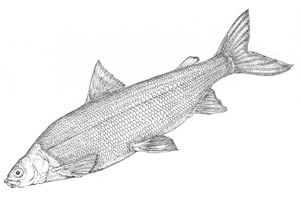 |
|
 |
|
|
Lake trout are coloured with light spots on a darker background and a light-coloured
belly. The background colour may vary from light green or grey to dark green,
brown or black.
One of the most widely spread fish in the Territories, the lake trout is found
throughout the Mackenzie, Thelon, Back and Coppermine drainage systems. Although
most angling has occurred on Great Slave and Great Bear Lakes, "lakers" are
plentiful and provide spectacular sport in hundreds of fast-flowing rivers and
streams. The best trophy recorded was a world record catch from Great Bear Lake
weighing 32.5 kg (72 lbs). Many others have come close to this, and 13 to 18
kg (30 to 40 lbs.) fish are common.
|
|
|
|
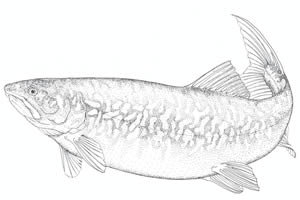 |
|
 |
|
|
Pike, or jackfish, prefer warm, slow, heavily vegetated rivers, or warm, weedy
bays of lakes. They occur throughout most of mainland Northwest Territories.
Pike have a long body with a dark green to brown colour along their back. The
sides are lighter and marked with 7 to 9 irregular vertical rows of yellow to
white, bean-shaped spots.
Pike generally run between 2 and 7 kg (5 to 15 lbs.), but quite a few pike
weighing 13 to 18 kg (30 to 40 lbs.) have been taken.
|
|
|
|
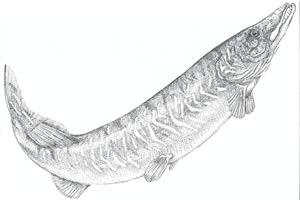 |
|
 |
|
|
Appropriately named the "unknown" by Alexander Mackenzie's French-Canadian
voyageurs, the inconnu is still largely unknown to most anglers. A member of
the whitefish family, it somewhat resembles a large herring with a dark back,
silvery sides and large scales.
Reports vary on the eating and sporting qualities of the "coney", but many
are caught in the Hay River in May or early June after break-up. They inhabit
the Buffalo, Taltson, and Anderson rivers and the Mackenzie Delta. Inconnu average
4 to 9 kg (9 to 20 lbs.), although commercial fishermen report some over 32
kg (70 lbs).
|
|
|
|
 |
|
 |
|
|
The loche is a bottom-feeding fish. Its liver is considered to be quite a delicacy
and a large loche might have a liver the size of a human hand. The liver is
very rich source of oil and fat. The loche is caught year-round, usually with
a hook baited with meat. The hook is left on the lake bottom until the bottom-feeding
loche snaps it up.
|
|
|
|
 |
|
 |
|
|
The arctic grayling is a beautiful fish: dark blue on the back and purple grey
on the sides. A distinctive characteristic is its large, sail-like dorsal fin,
which is coloured a blackish blue with violet spots.
Average weights are from 0.5 to 1 kg (1 to 2 lbs.), but the world record arctic
grayling was caught in the Great Bear Lake area and weighed 2.7 kg (6 lbs.).
The grayling is particularly common in the Mackenzie, Coppermine, Anderson,
Thelon and Back drainages. During the summer, they can be caught in cold, swift
rivers and in bays of some larger lakes.
|
|
|
|
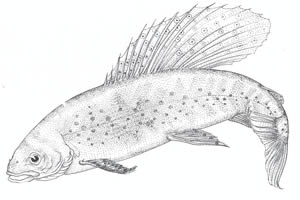 |
|
 |
|
|
The walleye is a member of the perch family and has sharp teeth and two dorsal
fins on its back, the front one supported by large spines. Walleye are olive-brown
flecked with gold, shading to a white belly. The large, silvery eyes are distinctive.
Also known as doré or pickerel, walleye are plentiful in smaller lakes around
Hay River and Yellowknife, and to a lesser extent farther north.
Walleye generally run up to 2.5 kg (5 lbs.). They are easiest to fish in the
spring when they are running in the rivers.
Fish Descriptions provided by the Department of Resources, Wildlife, and Economic
Development, Government of the Northwest Territories
|
|
|
|
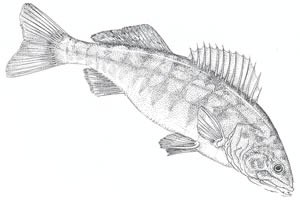 |
|
|
|
|
|
|
|

